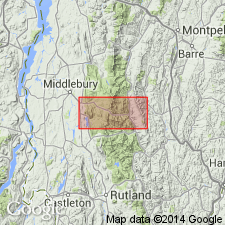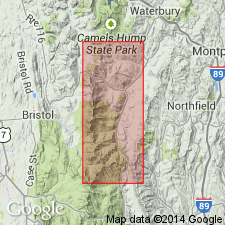
- Usage in publication:
-
- Granville formation
- Modifications:
-
- Named
- Dominant lithology:
-
- Schist
- Quartzite
- Marble
- AAPG geologic province:
-
- New England province
Summary:
Named the Granville formation for Granville, Rochester quad., Windsor Co., VT. Consists of gray to black rusty weathering graphitic albite-quartz-chlorite-muscovite schist with thin interbeds of blue-gray quartzite, dark green albite-epidote-calcite-chlorite schist, and lenses of buff colored dolomitic marble. Thickness is about 350 to 400 feet. Overlies the Monastery formation and underlies the Pinney Hollow formation. The Granville is of Early Cambrian age.
Source: GNU records (USGS DDS-6; Reston GNULEX).

- Usage in publication:
-
- Granville Formation
- Modifications:
-
- Revised
- AAPG geologic province:
-
- New England province
Summary:
Nomenclature follows T.R. Armstrong (in progress) who restricts the Granville Formation of Osberg (1952) by assigning the graphitic schist and dolomite to the Battell Formation (raised in rank) and including in the Granville only the carbonaceous albitic schists and quartzites. Carbonaceous albitic schist and super carbonaceous schist previously assigned to the Hazens Notch are now included in the Granville. The super carbonaceous schist is referred to as the Lincoln Gap Member. (Name was first introduced by Gordon (1927) in a Report of the State geologist, unavailable for review.)
Source: GNU records (USGS DDS-6; Reston GNULEX).
For more information, please contact Nancy Stamm, Geologic Names Committee Secretary.
Asterisk (*) indicates published by U.S. Geological Survey authors.
"No current usage" (†) implies that a name has been abandoned or has fallen into disuse. Former usage and, if known, replacement name given in parentheses ( ).
Slash (/) indicates name conflicts with nomenclatural guidelines (CSN, 1933; ACSN, 1961, 1970; NACSN, 1983, 2005, 2021). May be explained within brackets ([ ]).

